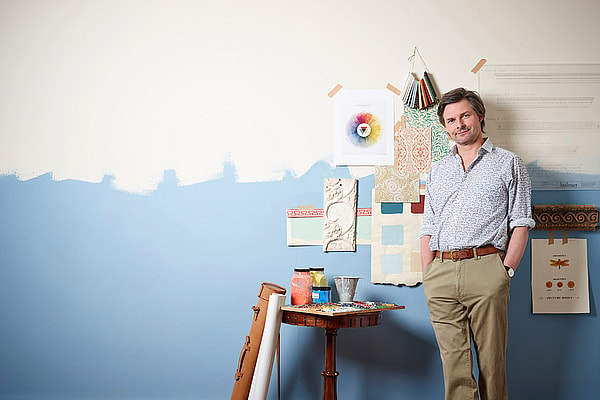Design Date – Edward Bulmer
An interior designer with a specialism in historic buildings, Edward Bulmer has worked across houses, castles and palaces to ensure that yesterday’s buildings are fit for purpose today. He also runs Edward Bulmer Natural Paints (available from Tissus d’Helene), whose products offer not just a palette that is sympathetic to period properties, but a formula that is healthy and chemical free. At Focus/18, he is speaking as part of a panel discussion about how our architectural heritage can be adapted for 21st-century living.
Conversations in Design:
Past, Present, Future: Reimagination and Renewal, 11.30am, Tuesday 18 September
Are you still surprised by the colours used by the homeowners/decorators of the past?
If I am surprised by anything, it is that there are various ‘rules’ that have been observed for so long. The one I encounter most often is the use of the traditional colour wheel to ensure that contrasting colours are used in a balanced way. It is so simple and it is why sometimes strong juxtapositions – red/green, yellow/blue – seem to work effortlessly. Robert Adam was pretty obsessed with using colour in this way and one is never surprised to be using a wide palette in the restoration of his schemes.
Should colour be historically accurate in a historic building? Or can it bridge the gap between old and new?
I believe that materials should be historically accurate in the sense of how they perform and when visible, how they appear. Paints have historically been made with a limited palette of pigments derived from minerals, and cloth has been dyed with a mixture of plant and animal dyes. Adopt these raw materials and you will have a colour spectrum that will be more harmonious; in my opinion this is the best way to bridge ‘gaps’ between old and new work.
As a maker of natural paint, are you heartened by the increase in interest in ‘the healthy home’?
Of course! People affected by paints with petro-chemical ingredients are not a tiny minority anymore – multiple chemical sensitivity (MCS) is now the fastest growing health concern for the NHS after obesity. Using natural paint not only keeps toxic emissions out of the air, it also helps to regulate moisture, one of the primary causes of damp. If you can control damp, then the building as well as its occupants will benefit.
What do you obsess over in your work?
Doing the right job – the right job, being the best job I can! Sometimes something can look right but it is badly made – it can only look right to me if it has been well and honestly made.
What’s been your most challenging project?
Setting up a paint business. It is a big and mature market and so the largest companies and the industry’s trade body have enormous influence. We never had the option of a fat marketing budget so we have built up sales by showing people examples of real homes transformed in look and feel by our paints. We have been able to capture attention through editorial and social media, so our message is getting out there despite our tiny size!
Where do you feel at your most creative?
When I create I am quarrying a vast visual memory bank fed by visiting so many historic buildings and by a sizeable reference library in my design studio. So it is true to say that home is where I am most creative, as my studio is in a converted farm building next to my house. This house was built around 1700 and is redolent with history – so if I need to clear my head I am blessed to be able to take a walk around its restored Georgian fish ponds.








